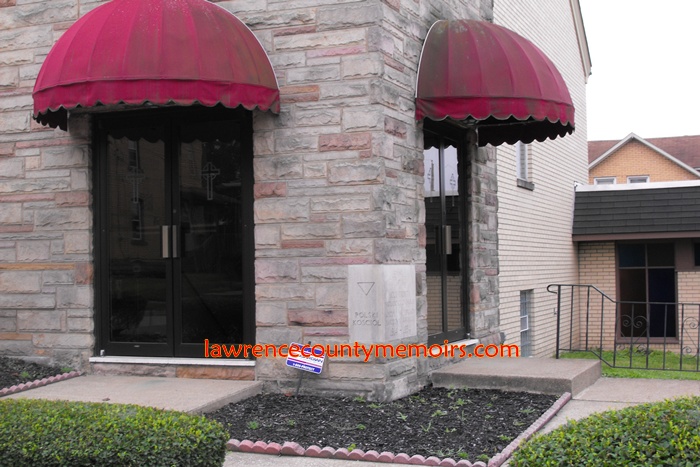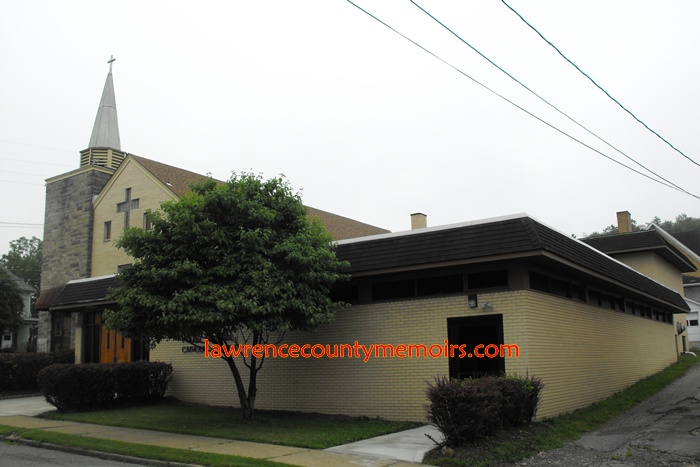The first large group of Polish-speaking immigrants began arriving into New Castle, Pennsylvania, in the early 1890’s. Most of these hard-working immigrants hailed from the countries of Germany, Russia, and Austria-Hungary and came to work in the coal mines and various mills. The country of Poland had been partitioned and absorbed by several nations in 1795, and would not be officially reinstated as a nation until 1918. Most of these immigrants settled into tight-knit Polish neighborhoods, were fiercely proud of their own heritage, and did not openly welcome being “Americanized.”
Many of these Polish-speaking immigrants were Catholic or interested in the Catholic religion, but had issues with the mainstream Catholic Church. Among the issues was the fact that there were no Polish bishops and only a handful of Polish priests, Polish-speaking sermons were rarely held, the Polish language was generally banned in the parochial schools, and the church property almost exclusively belonged to diocese vice the individual congregation.
Without a Polish-ethnic church of their own local Poles decided to attend services at St. Joseph’s Catholic Church, a German-ethnic parish located in downtown New Castle. Finally, in 1902, the Madonna of Czestochowa Catholic Parish/Church was established to cater to the Polish community in the Oakland district of Union Township.
Another group of Polish immigrants on the South Side – in the Sheep Hill neighborhood – sought to establish their own Catholic Church. They held a meeting in the social hall of St. Michael’s Catholic Church on January 4, 1913. They continued to organize themselves over the course of the next year. In late March 1913 they purchased a large piece of property on Miller Street – near the intersection with South Jefferson Street. A small church, followed by a rectory, was soon erected at the site. In February 1914 the Reverend Simon Guzik came from Cleveland and was assigned as the first pastor. On June 24, 1914, the congregation was officially chartered as the “Polish Catholic Church of Holy Trinity.”
The congregation had not consulted with the Catholic Diocese in Pittsburgh when it chartered its own church. The Diocese asked that ownership of the church and property be turned over, but the church leadership refused the request. A bitter dispute followed. Catholic Church officials soon took issue with the dissident group using the name “Catholic” in its charter and the case went to court in late 1914. The church dropped the name Catholic from its name and went it alone without affiliation to any religious denomination. In late 1916 a small cemetery for the congregation was also opened on Gardner Center Road in Shenango Township.
In February 1919 the church bought several lots of property at the southwest corner of Miller Street, and apparently the church building was “moved” a half-block to that new location. The old neighboring property and rectory was sold off.
In August 1919 the congregation decided to align itself with the Polish National Catholic Church (PNCC), a breakaway church founded in Scranton, Pennsylvania, in 1897. The group was essentially founded by the Reverend Franciszek Hodur (1866-1953), who became the church’s first bishop in 1907. The PNCC, which went on to established parishes throughout the United States, Canada, and Italy, sent emissaries to Poland after World War I and founded the affiliated “Polish Catholic Church” throughout that newly reinstated country.
On Wednesday, August 3, 1921, the Reverend Hodur visited New Castle. An article in the Wednesday, August 3, 1921, edition of the New Castle News reads, “The Rt. Rev. Hodur of Scranton, Pa., bishop of the Polish National Catholic Church, arrived in the city this afternoon at 3 o’clock to pay a visit to the Holy Trinity Polish parish, on South Jefferson Street. He was met at the station by a delegation of members of the parish and will have charge of services to be held this evening at 7 o’clock in Holy Trinity church. The bishop will be entertained at the home of the rector, Rev. Joseph Szyporsky, at 1703 South Jefferson street, during his stay here. He will leave Sunday morning for Johnstown.”
The mainstream Catholic officials in Pittsburgh did not sit by idle in regards to the growing Polish population of the Sheep Hill area. The S. S. Philip & James Catholic Parish and Church, a Polish-ethnic congregation, was established in August 1922. A towering church, located about two blocks away from Holy Trinity, was opened for services in late 1924.
The Holy Trinity congregation, usually referred to as the Holy Trinity Polish National Church, steadily grew in the predominately Polish neighborhood where it was located. A parochial school, which taught young child about their cultural heritage, was opened in September 1921. The church opened a community playground, named in honor of former U. S. President Woodrow Wilson, at the corner of Miller and South Jefferson in 1930. A June 16, 1930, article in the New Castle News reads in part, “Two hundred children enjoyed the equipment which has been erected. It is open to all children. There are 16 swings for children of various ages and three sliding boards.”
In the mid-1930’s the congregation began discussing plans to build a new church at the playground site. Fundraising efforts got underway and the W. G. Eckles Company was hired in 1939 to design a new stone church. An article in the New Castle News of Monday, July 16, 1939, reads, “Between 700 and 800 people gathered at the corner of South Jefferson street and Miller avenue, Sunday at 10:30 a. m., for the dedication of the ground for a beautiful new church for the Holy Trinity Polish National Catholic congregation. It was a memorable day for the congregation, not only because of the significance of the ceremony, but because of the presence of Most Rev. Jan Zenon Jasinski D.D., Bishop of the Buffalo-Pittsburgh Diocese… Mayor of New Castle Charles E. McGrath moved the first shovelful of earth and gave brief remarks of congratulation.”
The new church endeavor was soon shelved, apparently in partial response to the coming of World War II. Fund-raising efforts continued throughout the 1940’s. It wasn’t until March 20, 1954, that contracts for the construction of the new church were signed by church officials. Construction soon got underway on a new stone church designed by the W. G. Eckles Company. This church was different than the drawings completed by the Eckles firm back in 1939.
The Reverend Daniel Driscoll, who took over as the pastor of Holy Trinity in July 1953, took part in the ceremonies when the new church was dedicated during the weekend of November 13-14, 1954. The old church, located next door, was converted into a social hall.
On Sunday, October 25, 1964, the congregation celebrated the 50th anniversary of its founding. The faithful Reverend Marcell W. Pytlarz, who had just recently arrived, oversaw the ceremony. Pyltarz soon settled in and became the longtime pastor of the church. In early 1965 the church began plans to build a new annex, which would include a new social hall and Sunday school addition. The work, which including the remodeling of the church’s basement, began in June 1966. The 11-month project was designed by the W. G. Eckles Company and cost about $100,000. The new addition was officially dedicated on Sunday, May 21, 1967. About 350 people attended an impressive ceremony presided over by the Reverend Thaddeus F. Zielinski, the Bishop of the Buffalo-Pittsburgh Diocese.
High-level talks between officials of the Polish National Catholic Church and the Roman Catholic Church about a reunification began in 1986 and continued for several decades. The Polish National Catholic Church remains a separate denomination, but relations have greatly improved with the Catholic Church in Rome.
The Holy Trinity Church in New Castle has always played an important role in the local Polish community and helped establish the annual Polish Day celebration beginning in 1980. The church lost an icon in late August 2009, when the Reverend Pytlarz retired after serving the church and community for an amazing forty-five years. The church will proudly celebrate its 100th anniversary sometime in 2014.
 A small group of Polish-speaking immigrants residing in the Sheep Hill neighborhood began holding formal Catholic services in early 1914. A lot was purchased along Miller Street and a small church (shown above) was erected during the summer of 1914. The congregation was soon in open dispute with Catholic officials and decided to go it alone as a non-denominational church. In August 1919 the congregation aligned itself with the breakaway Polish National Catholic Church (PNCC) and become known as the Holy Trinity Polish National Catholic Church. (c1915) (Photo courtesy of Bill Cwynar) Full Size |
 A class of the Polish language school held at the church. In the middle back is the Reverend Joseph Szyperski and towards the left back is organist and teacher Wiktor Zakrzewski. (c1922) (Photo courtesy of Bill Cwynar) Full Size |
 |
 The congregation held services in the small church until the new Holy Trinity Church (shown above) was opened in November 1954. The church remains in service and will celebrate its 100th anniversary in 2014. (Jul 2013) Full Size |
 (Jul 2013) |  (Jul 2013) |
 (Jul 2013) |  (Jul 2013) |
 (Jul 2013) Full Size |
 (Jul 2013) |  (Jul 2013) |
 (Jul 2013) |  (Jul 2013) |
 (Jul 2013) Full Size |






Comments
Patti Data Houk #
I was born into this church and was baptized, had first communion and confirmation and spent my teen years in the many activities. I attended Polish school for many years and became fluent in the language. There were a variety of things for young children to do…as there was no TV. Boys basketball, girls embroidery, choir practice and holiday parties. In the summer, we would spend a week at Spojnia Camp in Scranton, where I was a counselor. Memories flood back of the fun we had with Fr Driscoll, who one evening, “borrowed” an old car owned by another priest and took the New Castle counselors out for a custard. I was married in this church by Fr Driscoll, in 1957 and my children attended until they moved away. I still attend services there. Thanks for bringing back these memories, Leon.
Trudy bennardo #
Hello I am in search of my father’s history. I am told his birth name was stanley adam palkavich. He changed his last name to Paul and married my mother, Gertrude M. STEVENS.
There was one name I can remember, Agnes and a man who was a teacher. Do you have knowledge of any above information?
Jan Sanejko #
Good day,
as i was looking for my ancestors i found John Swanejko & his family ( wich is quite close to sanejko ) I found him in US 1940 census documents. Do you as a Church happen to have any old books of birth or any other documents that might help me find what is my relation with his family, and are there maybe some living relatives?
Here’s my source:
http://www.archives.com/1940-census/john-swanejko-pa-67500026
Oczywiście jeśli to nie problem możemy też komunikować się po polsku.
God bless,
Pozdrawiam serdecznie,
Jan Sanejko
lisa yarosz #
If someone could please help me I would greatly appreciate it. I did the family history for Walter John Yarosz. He is my grandfather. According to his birth certificate his birth mothers maiden name is Josephine Gacez. Walter, no middle name listed on birth certificate, born may 3, 1920 New Castle, Lawrence, PA. His last name listed is Yarosz. the next document i have is his baptismal record Holy Trinity Parish 1708 south jefferson st., New castle. the baptismal is dated May 23, 1920. The parents listed are Franciszek Jarosz and Jozefa Biala. Sponsors listed are Wawrzyniec Gruca and Karolina Walczak. the Priest who preformed the baptism is Rev. T.W. Jakimowicz. I am searching for his birth father that was not listed. If there are records at the church that could help me that would be wonderful.Thank you so much, Lisa Yarosz
Comment